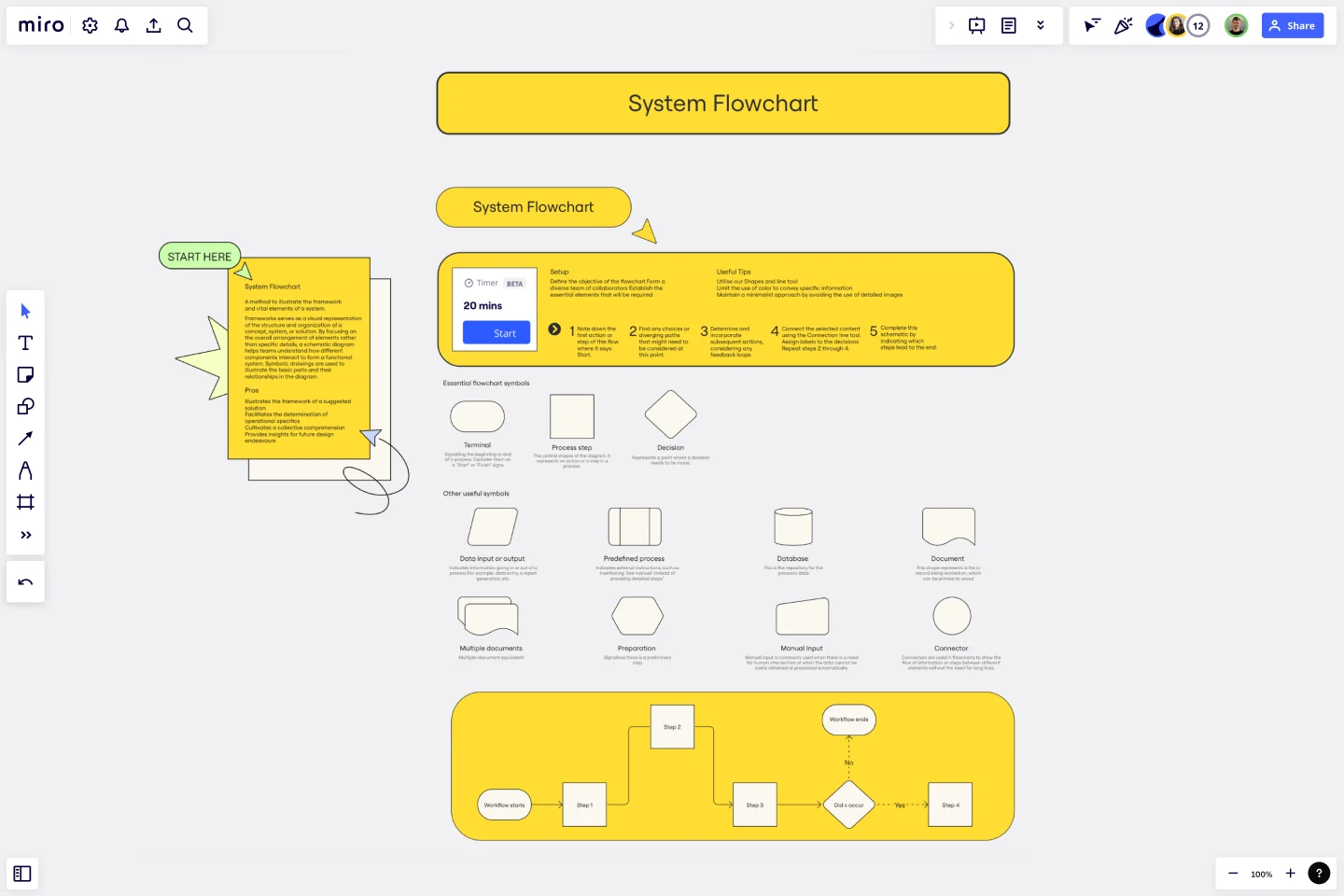System Flowchart Template
Illustrate a system's framework and vital elements with the System Flowchart Template.
About the System Flowchart Template
The System Flowchart Template visually represents the structure and organization of a concept, system, or solution. It provides a high-level view of the system by focusing on the overall arrangement of elements rather than specific details. It helps teams understand how different components interact to form a functional system.
Although these frameworks are frequently used in technical fields, they can also be utilized in non-technical fields to assist teams in comprehending complex concepts or processes. They provide a shared language and understanding of the system, which ensures that everyone is aligned and working towards the same objectives.
Benefits of using the template
Illustrate the framework of a suggested solution.
Facilitate the determination of operational specifics.
Cultivate a collective comprehension.
Provide insights for future design endeavors.
How to use the template in Miro
Note down this flow's first action or step where it says: Start.
Find any choices or diverging paths that might need to be considered at this point.
Determine and incorporate subsequent actions, considering any feedback loops.
Connect the selected content using the Connection line tool. Assign labels to the decisions. Repeat steps 2 through 4.
Complete this schematic by indicating which steps lead to the end.
Setup
Define the objective of the flowchart.
Form a diverse team of collaborators.
Establish the essential elements that will be required.
Useful tips
Utilize our Shapes and line tool.
Limit the use of color to convey specific information.
Maintain a minimalist approach by avoiding the use of detailed images.
Get started with this template right now.
Basic Storyboard Template
Works best for:
Storyboard
The Basic Storyboard template helps visualize and plan creative projects by breaking down scenes into manageable parts. With spaces for visuals, dialogue, audio, and notes, it ensures clarity and organization. Perfect for teams in film, animation, or presentations, this template enhances communication and saves time by providing a structured format to plan, review, and refine your project’s narrative and flow.
Empathy Map by Back of the Napkin Consulting
Works best for:
Research & Design, Market Research
The Empathy Map template is designed to help you understand your users deeply. It captures user behaviors, thoughts, and feelings, allowing you to design products that truly resonate with their needs. Use this template to enhance your UX research and create user-centered designs.
Analytics Storyboard
Works best for:
Planning, Storyboard, Design
Visualize your data insights with the Analytics Storyboard template. This tool is perfect for data analysts and business intelligence teams, helping you present complex data in a clear and engaging narrative format. It includes sections for data sources, key findings, and visualizations, ensuring your audience can easily understand and act on your insights. Use this template to create compelling data stories that drive informed decision-making and strategic planning.
Moderated Usability Testing Template
Works best for:
Design
Encouraging individuals to express their implicit ideas helps identify the strengths and weaknesses of a design, and Moderated Usability Testing Template provides valuable perspectives. Typically, conducting only six to nine of these tests uncovers 80% of design issues, making it a cost-effective method to enhance potential solutions.
iPhone App Template
Works best for:
UX Design, Desk Research, Wireframes
Incredible percentages of smartphone users worldwide have chosen iPhones (including some of your existing and potential customers), and those users simply love their apps. But designing and creating an iPhone app from scratch can be one seriously daunting, effort-intensive task. Not here — this template makes it easy. You’ll be able to customize designs, create interactive protocols, share with your collaborators, iterate as a team, and ultimately develop an iPhone app your customers will love.
UXD Empathy Map Template
Works best for:
Research & Design, Market Research
UXD Empathy Map helps you gain a deep understanding of your users. By mapping their experiences, thoughts, and emotions, you can design products that truly resonate. This template is perfect for UX designers aiming to create user-centered designs.
